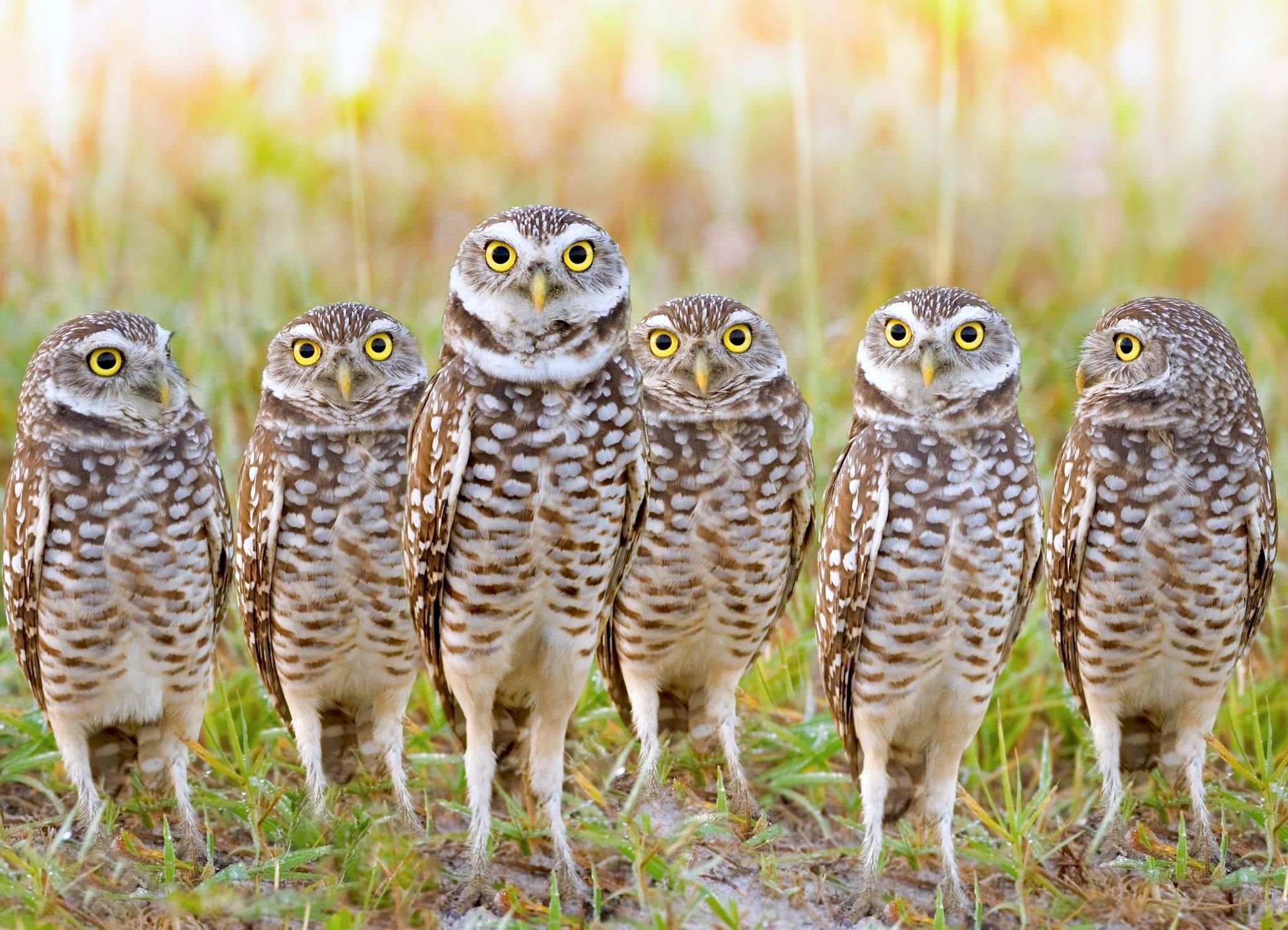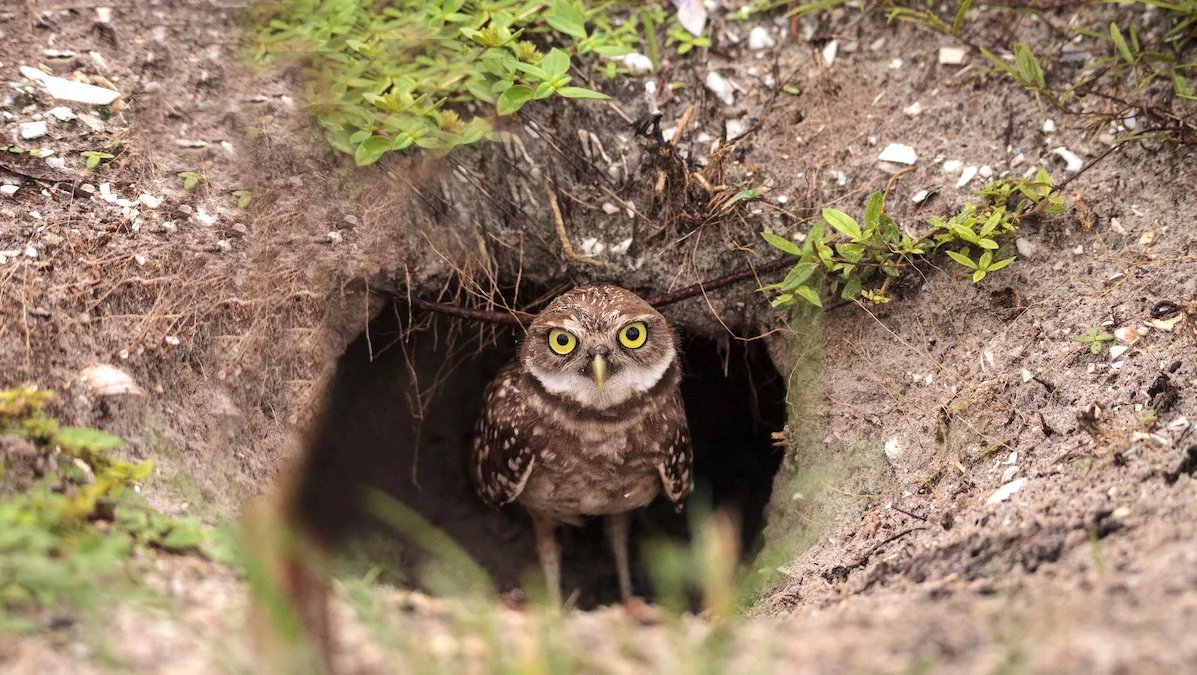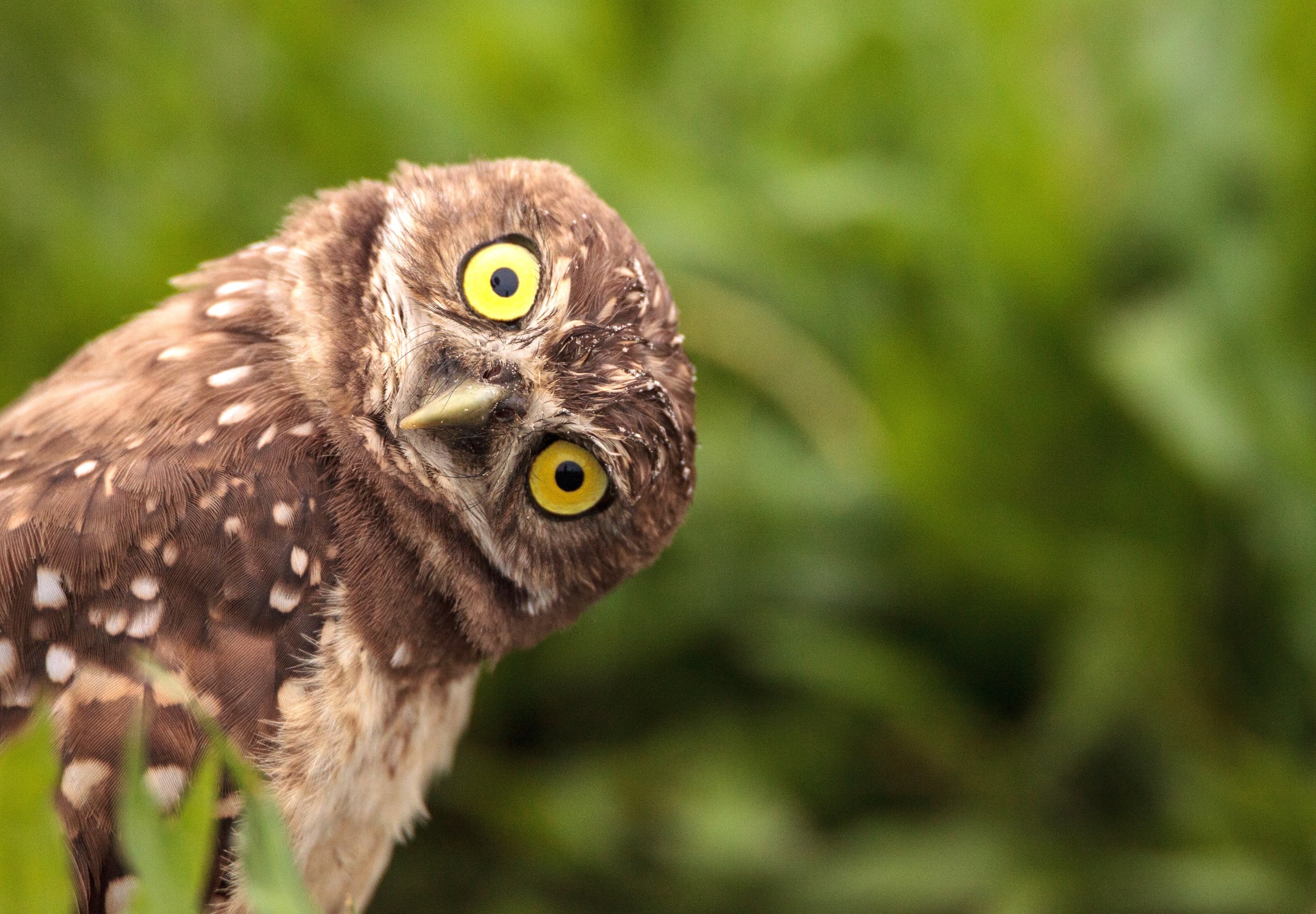1868 | Lapwai Creek, Idaho, USA
Burrowing owl (Athene cunicularia) dung baiting
Often I write these posts to highlight unexpected tool-use behaviour, or to dive into the latest discoveries of animal technologies, or to help us look at familiar creatures in a new light. But sometimes all I really want is an excuse to share adorable photos of curious critters. This is one of those times.
Meet the burrowing owl:
See what I mean? But don’t worry, this is a tool use tale as well.
Tunnel vision
The burrowing owl is found throughout the Americas, wherever there is open grassland. Their common name is apt: they are the only owls that make their homes underground, either digging out a tunnel with their powerful legs, or taking over a burrow left by another animal such as ground squirrels or prairie dogs. The species name is also spot on, combining the genus Athene—after the goddess of wisdom—with the epithet cunicularia, for a burrow or passage. (That word also gave us the formerly popular term ‘coneys’ for rabbits.)
One of the earlier descriptions of the owl’s behaviour comes from the keen eyes of a US Army major, originally from Germany, who fought in the American Civil War. Major Charles E. Bendire was regularly posted to remote locations during his service, and to keep himself occupied he became a student of the birdlife he saw around army forts.
In 1892 he published many of his observations in a book for the Smithsonian Institution, Life histories of North American birds with special reference to their breeding habits and eggs. His sightings of the burrowing owl were helped by another of this bird’s unusual habits: it is diurnal, staying awake during the day. It also keeps close to the ground, and to its burrow, making it easy to spot once you get past the mottled brown feathery camouflage.
Here’s another one keeping watch at its burrow, this time in Florida:
And here’s Bendire reporting on an owl clearing out and enlarging its burrow in the late 1860s, near what was then Fort Lapwai in north-central Idaho (now part of the Nez Perce National Historical Park):
The loosened dirt was thrown out backward with vigorous kicks of the feet, the bird backing gradually toward the entrance and moving the dirt outward in this manner as it advanced. These burrows vary greatly in length and depth, and are rarely less than 5 feet in length and frequently 10 feet and over…These burrows are generally about 5 inches in diameter, and the nesting chamber is usually from 1 foot to 18 inches wide. After the burrow is suitably enlarged, especially at the end, dry horse and cow dung is brought to the entrance of it, where it is broken up in small pieces, carried in and spread out in the nesting chamber which is usually lined with this material to a thickness of 1 or 2 inches, and I have never found any other material in the nest. In California, however, they are said to line them occasionally with dry grasses, weed stalks, feathers, and similar materials. On one thing most observers agree, namely, that their burrows invariably swarm with fleas.
Fleas aside, there is one part of this description I want to focus on: the deliberate placing of horse and cow dung in and around the nest. What are the owls doing?
Meet the beetles
If you’ve been reading this blog for a while you may remember that we’ve seen animals use manure as a tool before. Bees in Vietnam place spots of chicken, pig and water buffalo poop around the entrance to their nests to deter predatory giant hornets. Perhaps this is a similar behaviour, keeping the owl’s burrow/nest from discovery or invasion. After all, most animals will avoid dung if they can.
Unless you’re a beetle. In 2004, Douglas Levey of the Zoology Department at the University of Florida was supervising his usual undergraduate field trip to see the local wildlife. The group noticed that many of the burrowing owl pellets they found—the regurgitated undigestible parts of owl meals—contained bits of dung beetle. Along with the dung decoration, this suggested a hypothesis: the owls were deliberately baiting their homes with manure to attract prey.
The next step was some classic field ethology. To test whether dung was more likely to be deterring predators or attracting beetles, Levey and his colleagues made 50 egg-containing burrows and placed manure around half of them (the researchers didn’t use live baby owls for very valid ethical reasons). After three and a half weeks, every nest but one was found and destroyed by predators. Dung didn’t stop them.
What about the insects then? The team removed all insect parts, owl pellets and dung from two occupied burrows, then placed just over 200g of dry cow manure (an average amount) around one of the sites. The other site was left clean as a control. The scientists returned after four days, collected everything again and switched the burrow that got the dung for a second round.
The results showed clearly that poop means food. Owls with nearby cow offerings ate ten times as many dung beetles and six times as many dung-beetle species as those with a clean front yard. Because the team had switched the control and test burrows part-way through, they could rule out local abundance of beetles or other environmental factors as the cause.
An attractive repellant
However, you may be thinking that predator avoidance and food attraction aren’t the only options here. If so, you’re thinking like Matthew Smith and Courtney Conway of the University of Arizona. In 2007 they published a paper that looked at two extra possibilities for having a poopy front porch: perhaps the material spread by male owls attracts females of their own species, or maybe it simply signals that a given burrow is occupied, and any house-hunting owls should look elsewhere.
Smith and Conway noted that burrowing owls aren’t only spreading dung. Modern materials such as paper, plastic and tinfoil are also brought to the nest, and recall that Bendire reported nineteenth-century California owls using grass and feathers. Those don’t seem like the kinds of things that attract beetles or repel predators. Systematically, then, the researchers set about testing their new set of hypotheses.
The first possibility, that male owls were attracting not food but potential mates, didn’t hold up. The nests were decorated only after mate pairs were established. But the idea that the scattered material acts as a ‘no vacancy’ sign was more promising. The scientists added manure to some empty burrows, and removed material from others, and the dung-marked holes were less likely to then become owl nests. Similarly, when the researchers put a stuffed owl nearby and played owl calls, the resident owls added more material around their nest than when a stuffed starling was used. However, neither of the tests was statistically definitive.
What did gain support, again, was the prey attraction idea. Arthropods were much more common at manure-baited sites, and not just dung beetles. Scorpions and a wide variety of beetles were also more prevalent, with an average of 69% more bug biomass at dung burrows. In their study, Smith and Conway didn’t find that the beetle difference translated into better survival rates for young owl chicks, but they noted that it may have increased the condition of those youngsters.
Which gives us another chance for a photo—here are some burrowing owl juveniles in Southern California, working on perfecting that adult stare:
In a follow-up study published in 2011, Smith and Conway looked more closely at those other bits of stuff that owls brought to their nests. When given the option, they found that owls preferred cow and horse dung and grass over carpet fabric and aluminium foil. The more manure found at a nest, the less other materials were around, again suggesting a preference for the smelly stuff, but this pattern was not universal. One burrowing owl even shredded and used the cardboard box that the scientists were using to hold manure and grass samples.
It may not surprise you that the current state of play in owl-dung research is that more research is needed. As Smith and Conway point out:
Future studies might productively examine the extent to which the other materials used by Burrowing Owls attract insects (and if so, how) throughout the breeding range of Burrowing Owls. Additionally, quantifying the effect of the presence of manure on juvenile survival and other factors related to fitness is necessary. We believe that until such studies are completed, the mystery as to why Burrowing Owls collect and scatter mammal manure and other debris around their nesting burrows remains unresolved.
The good news is, that if you live in one of the countries in the Americas that these yellow-eyed diggers call home—from Canada to Chile—you can contribute to solving this mystery. Patience, binoculars and a notebook are all you need, although you should always take care not to disturb the animals or to change their nests in any way (unless you’re a research scientist with ethical and regulatory approval!). And even if you don’t get all the answers, at least you’ll have a pleasant day in the company of these inquisitive and very unusual birds.
But that's not owl folks…
Want more burrowing owls? Of course you do. It’s not tool use, but let’s spend a few minutes with Charles Bendire’s intellectual descendants at the Smithsonian Channel, in the company of an owl couple and their underground refuge:
Sources: Bendire, C.E. (1892) Life histories of North American birds with special reference to their breeding habits and eggs. Smithsonian Contributions to Knowledge, vol. 25. Smithsonian Institution, Washington. || Levey, D. et al. (2004) Use of dung as a tool by burrowing owls. Nature 431:39. || Smith, M. & C. Conway (2007) Use of mammal manure by nesting burrowing owls: a test of four functional hypotheses. Animal Behaviour 73:65-73. || Martin, D. (1973) Selected Aspects of Burrowing Owl Ecology and Behavior. The Condor 75:446-456. || Smith, M. & C. Conway (2011) Collection of Mammal Manure and Other Debris By Nesting Burrowing Owls. Journal of Raptor Research 45 220-228.
Main image credit: Nevada Department of Wildlife; https://www.ndow.org/species/western-burrowing-owl/ || Second image credit: Life’s Extraordinary Creatures; https://ar.pinterest.com/vz6988/ || Third image credit: EcoWatch; https://www.ecowatch.com/wp-content/uploads/2021/10/1125261365-origin.jpg || Fourth image credit: SunflowerMomma; https://www.theatlantic.com/photo/2020/02/photos-superb-owl-sunday-iv/605854/ || Fifth image credit: Peter Brannon; https://www.flickr.com/photos/peterbrannon/47586135431 || Sixth image credit: Southwest Explorers; https://southwestexplorers.com/what-is-a-burrowing-owl/





